- cross-posted to:
- space
- becomeme@sh.itjust.works
- cross-posted to:
- space
- becomeme@sh.itjust.works
For nearly 25 years, we thought we knew how the Universe would end. Now, new measurements point to a profoundly different conclusion.
If you can measure the Universe’s expansion rate today and how its expansion rate has changed over its history, you should be able to determine what it’s made of and, therefore, what its ultimate fate will be.
Starting in the late 1990s, combinations of large-scale structure data, supernova data, and CMB data all pointed toward a single picture: a dark energy-dominated Universe that would end in a “big freeze.”
Now in 2024, however, the picture has gotten a lot murkier. The Hubble tension, along with new results from DESI, throw our consensus picture into doubt. Here’s why we now question the fate of the Universe.
…physicists have been questioning the fate of the universe since “physicist” became a thing.
Perhaps dark energy isn’t truly a constant, after all. Perhaps it is something that changes and evolves with time. If so, our cosmic fate could dramatically differ from what we typically suppose. If dark energy strengthens and becomes more negative with time, it could lead to a Big Rip. If it weakens and becomes more positive, it could potentially stop the Universe from accelerating and may even revive the possibility that we’ll recollapse and end in a Big Crunch.
Kurzgesagt did a cool video about this a few months ago





